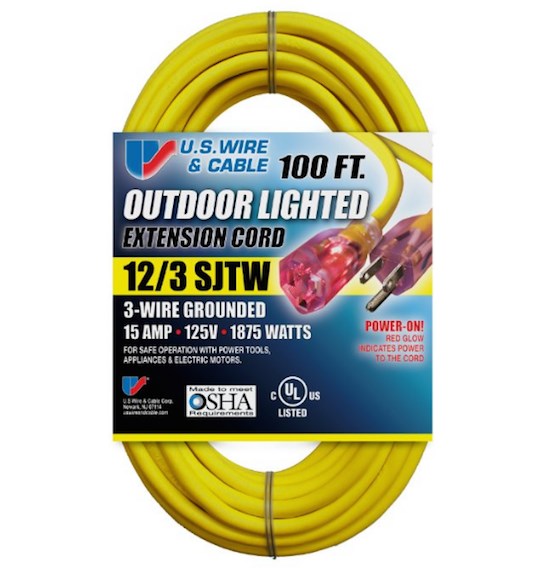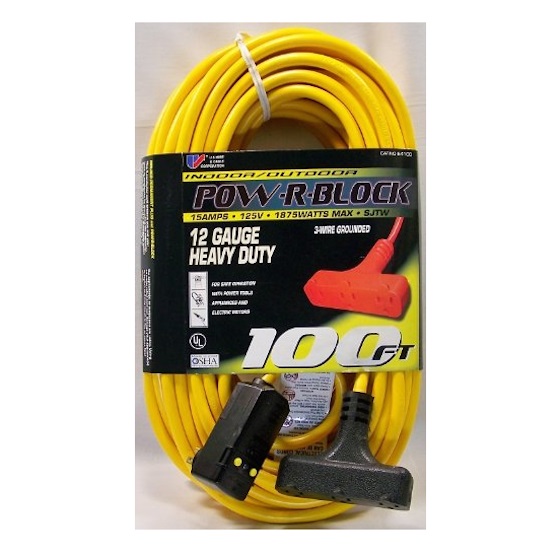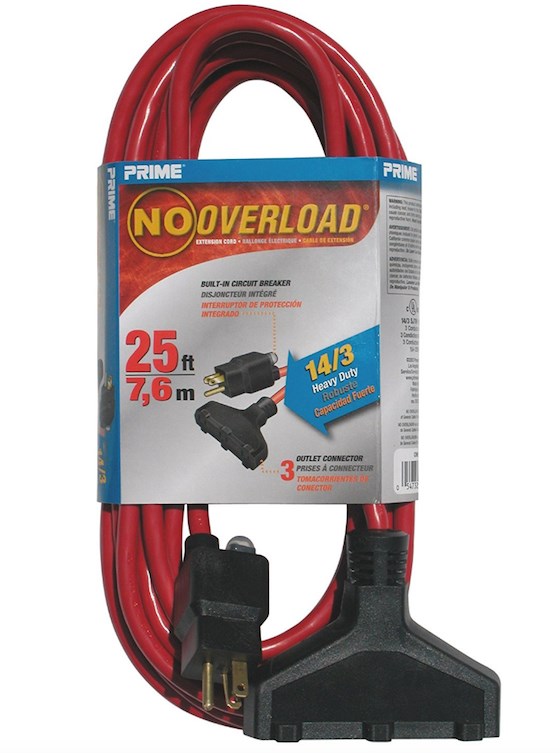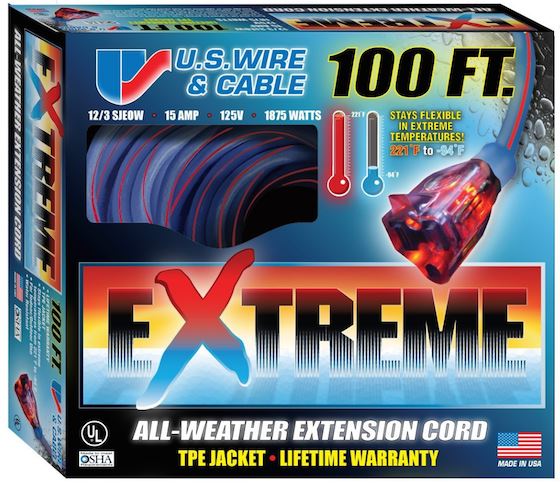Extension Cord Size

This is a beefy 12-gauge extension cord. You can see the 12/3 number on the label. 12-gauge wire is normally rated for 20 amps and 2400 watts, but this one may be underrated because it's stranded wire in the cable. No matter, this cord can deliver lots of juice! CLICK THE PHOTO NOW TO HAVE THIS CORD DELIVERED TO YOUR HOME.
Extension Cord Size TIPS
- Voltage drops when electric travels long distances
- Use heavy 12-gauge cords to prevent damage and fires
- Get cords with GFCI breakers built in
- Some cords have circuit breakers to prevent FIRES
- CLICK HERE to Get Tim's FREE & FUNNY Newsletter!
DEAR TIM: My electric hedge trimmer, chain saw and other tools seem to struggle when I use them outside. The size of my yard requires me to use a 100-foot extension cord.
The motor on one tool has already failed after just two years. What's causing this?
Are there new improvements in extension cords that can prevent electric tool failures and other electrical accidents? Susan, Clemson, SC
DEAR SUSAN: The electric motor sensor in your tool was probably caused by overheating.
Low Voltage Ruins Electric Motors
The excessive heat within the motor was very likely caused by low voltage. My best guess is that you are using an undersized extension cord.
Thousands of electric tools die each year prematurely because they are starved for voltage by thin, undersized extension cords. Your other electric tools suffer every time you plug them into that cord.
Free & Fast Bids
Different Wire Gauges
Not all extension cords are created equal. Within the outer insulation of an extension cord you'll find wires that contain different amounts of copper.
Wires that contain more copper can supply your tools with more power. Wire size is measured by the gauge or thickness of the wire.
Smaller Number = More Power / Confusing!
You will often see numbers like 16, 14 or 12 gauge on extension cord wrappers. Believe it or not, as the number gets smaller, the thickness of the copper wire gets bigger!
Thus, a 12 gauge wire can carry significantly more power than a 16-gauge wire. My guess is that your extension cord is a 16 gauge or possibly an inferior 18-gauge cord.
Long Wires = Voltage Drop
Long extension cords can cause excessive resistance and voltage drop. Voltage drop will damage tools.
You can minimize this damage by selecting the proper length cord for the job.
Use Shortest Cord Possible
The best advice is to always use the shortest extension cord possible when powering a tool or device. You may have to purchase cords of varying lengths to power tools. I happen to own cords that range in length from 25 feet up to 100 feet.
GFCI Breakers Built In
You can protect your tools and yourself with many of the new and exciting improvements in extension cords. One of my favorites are the new, short extension cords that contain ground fault circuit breakers.

This 12-gauge cord has a GFCI circuit breaker built into the end where you plug it into a wall outlet. This will protect you in WET situations. CLICK THE PHOTO NOW TO HAVE THIS CORD DELIVERED TO YOUR HOME.
These nifty cords allow you to work safely in damp grass or other locations where you are operating outdoor electrical equipment near water. The ultra-sensitive ground fault breakers, housed within the cord, can sense short circuits before you get shocked. These devices are a must if you work in wet locations.

Here's an extension cord that's got a built-in breaker. If you try to overload it so it would OVERHEAT and catch on FIRE, the built-in breaker SAVES you. CLICK THE PHOTO NOW TO HAVE THIS SAFE CORD DELIVERED TO YOUR HOME.
You can also purchase short extension cords that contain miniature circuit breakers. These cords sense voltage drops in long cords and will cut off the power to the tool before the motor can be damaged.
Soft & Supple In Cold WX
If you're frustrated by stiff extension cords that become unruly in cold temperatures, look for cords that contain rubber in the outer insulation covering. The rubber compounds allow the cords to stay flexible and supple even at temperatures well below 0 degrees F.

This cord has special insulation that allows it to be soft and supple in COLD weather. It also sports an LED in the female end telling you it's plugged in and ready to go! CLICK THE PHOTO NOW TO HAVE THIS WONDERFUL CORD IN YOUR HOME NEXT WEEK.
Have you ever plugged in a tool and had no power? Finding the source of the problem is now easy if you use a cord with a lighted end. A small night-light type bulb is permanently fused in the end of a clear plug end. The cord just above has this feature.
If there is power at the end of the cord, the light glows. You can purchase simple adapters that tell you the same thing if you wish to have this convenience for your existing extension cords.
Column 174